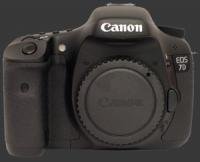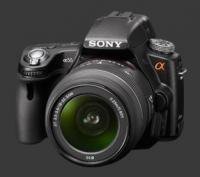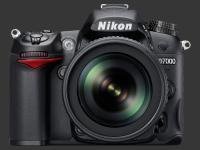Nikon D7000 Review
Nikon D7000 Performance - How well does it take pictures?
Ultimately, it is the image quality that makes a camera worth buying. For a digital SLR, image quality greatly depends on the lens used. While color, noise, contrast and exposure are properties of the camera, distortion, vignetting and chromatic aberrations are properties of the lens. Sharpness depends on the weakest link. So, the camera cannot capture more details than the lens lets through. Conversely, it is possible for a lens to transmit more details than the sensor can capture.
The Nikon D7000 unsurprisingly produces images of with extremely low noise. Having seen the same sensor several times already in various cameras, we can say that the D7000 is using it very well, closely matching first-place performance with the Pentax K-5
Pentax K-5 among current cropped-sensor DSLRs. As some may have noticed, this even surpasses the previous generation of full-frame DSLRs.
 This DSLR shows impeccable results at ISO 100 to 800 with image noise barely appearing at 1600. Still this does remain usable for large prints. ISO 3200 has clearly visible noise but retains details well. Print sizes are slightly reduced but, given 16 megapixels of resolution, even a medium 12"x8" print is absolutely perfect. ISO 6400 shows a moderate amount of noise which is barely visible in dark areas of a medium-size print. Nikon chose the standard ISO range well. Once in expanded ISO territory noise becomes destructive and eats away fine details. Still, ISO 12800 is usable in small print sizes and even 25600 can be used for a small 4"x6".
This DSLR shows impeccable results at ISO 100 to 800 with image noise barely appearing at 1600. Still this does remain usable for large prints. ISO 3200 has clearly visible noise but retains details well. Print sizes are slightly reduced but, given 16 megapixels of resolution, even a medium 12"x8" print is absolutely perfect. ISO 6400 shows a moderate amount of noise which is barely visible in dark areas of a medium-size print. Nikon chose the standard ISO range well. Once in expanded ISO territory noise becomes destructive and eats away fine details. Still, ISO 12800 is usable in small print sizes and even 25600 can be used for a small 4"x6".
The Nikon Matrix metering system used in the D7000 is mostly reliable but it is highly weighted by the center of the frame. This causes it to over-expose more often that usual. The metering formula is tuned to produce bright results, sacrificing highlights along the way. This is a more consumer-oriented approach that produces more print-ready output. So, while underexposure rarely happens, ½ stop of overexposure is not uncommon enough. Nikon provides a customizable metering offset of ±1 EV in 1/6 EV increments that can be set independently for each metering mode. This is great since Spot and Average metering work exactly as expected.
Image parameters provide a good amount of fine-grain flexibility in terms of color rendition. There are six picture styles offering various degrees of realism. Vivid is not as extremely punchy as on previous Nikon DSLRs but still as visibly over-saturated. The Standard picture style is the closest to reality but is slightly too warm. This is easily corrected by setting Hue to -1. So, while default colors are not entirely realistic, the D7000 is capable of producing accurate colors with the right settings.
The default sharpness is visibly soft but increasing it by 2 or 3 steps greatly improves results without noticeable artifacts. The default saturation for the Standard picture still is spot-on though, as is brightness. Default contrast is good too but that depends on the medium.
Automatic white-balance is generally good and cancels out color-casts under most conditions. The two Auto settings vary in how they deal with the warm color-cast typical of tungsten lighting. One setting tries to correct for it and the other does not. The one trying to neutralize all color-casts occasionally misses, particularly with CFL lighting. Still, this performance is better than average.
 The Nikon D7000 is a very fast and responsive camera. It speed is characterized by the following performance numbers:
The Nikon D7000 is a very fast and responsive camera. It speed is characterized by the following performance numbers:
- Power On: Instant.
- Power Off: Under 1s.
- Autofocus: As little as ¼s, up to 1s with a slow lens such as the kit Nikkor DX 18-105mm F/3.5-5.6G ED.
- Focus Confirm: Nearly instant for both autofocus and manual focus.
- Shutter-lag: Nearly instant followed by extremely short black-out.
- Shot-to-Shot Speed: Just under ½s.
- Instant Review: About ½s.
- Playback Mode: ½s - 1½s.
- Shooting Mode: Instant.
This camera features automatic distortion correction based on pre-programmed lens data. Due to the nature of optical distortion, parts of the captured image get cropped, making precise framing impossible. Enabling lens Distortion Correction slows the D7000 down by adding ½s to the Instant Review delay. It also reduces buffer-depth for 6 FPS JPEG continuous shooting from 15 to 8.
The 39-point autofocus system used on the D7000 is blazingly fast and only appears to be slowed down by slow lenses. When manual focusing, the camera instantly confirms focus. Even when autmatically choosing focus-points, this DSLR focuses quickly. Forcing use of the center-point makes AF even faster. Continuous autofocus is top notch and manages to keep up with both subject and camera motion reasonably well.
Battery-life is excellent, achieving 1050 shots-per-charge according to the CIPA standard. Keep in mind, as usual, that this number accounts for 50% flash use but not video recording and multiple revisions of images.
Nikon D7000 Performance - How well does it shoot video?
Nikon started with video capable DSLRs by introducing the D90. As the accepted replacement for that camera, the D7000 advances things further. This includes full 1080p HD capture with full-time autofocus and external stereo sound through a mini-jack connector.
 Video is captured by first entering Live-View. A dedicated Video Record button starts recording after a 1s delay. Pressing the same button ends recording after a ½s delay. Since there is no Video mode, the camera shows the 3:2 aspect-ratio preview necessary to frame still images. The D7000 includes a display mode with shaded areas at the top and bottom to make it possible to frame HD video properly. Anything falling in these areas does not get recorded. Not only are those shade areas difficult to see over certain backgrounds, they also do not disappear during video capture, making it easy to let a desired part of the subject slip out of the recording area. This display mode is also exclusive of other display modes, so it is not possible to frame video properly and see the digital-level or framing-grid.
Video is captured by first entering Live-View. A dedicated Video Record button starts recording after a 1s delay. Pressing the same button ends recording after a ½s delay. Since there is no Video mode, the camera shows the 3:2 aspect-ratio preview necessary to frame still images. The D7000 includes a display mode with shaded areas at the top and bottom to make it possible to frame HD video properly. Anything falling in these areas does not get recorded. Not only are those shade areas difficult to see over certain backgrounds, they also do not disappear during video capture, making it easy to let a desired part of the subject slip out of the recording area. This display mode is also exclusive of other display modes, so it is not possible to frame video properly and see the digital-level or framing-grid.
There are 8 video quality options on the D7000. The highest 1920x1080 resolution records at 24 FPS and is available with two levels of compression. The resolution below of 720p, which is 1280x720, can be recorded at 30 or 24 FPS with two levels of compression. Lastly, an unusual 640x424 @ 30 FPS 3:2 aspect-ratio video option is also available in two qualities.
The Nikon D7000 has a built-in microphone which can be turned off. Sound can also be set automatically or manually to one of 3 sensitivity levels. Optionally an external stereo sound source can be connected to the mini-jack connector. Nikon makes the ME-1 Stereo Microphone which attaches to the hot-shoe.
Contrast-Detect Autofocus is possible during video recording. In AF-S focus-drive mode, autofocus is performed each time the shutter-release is pressed halfway. This is available before or during video capture. In continuous autofocus mode, labeled AF-F instead of AF-C, focus is constantly adjusted. If it locks incorrectly, pressing the shutter-release makes it try again.
 Four AF-areas options are available during Live-View and video capture: Wide, Normal, Tracking and Face-Detect. The latter two actually work in conjunction with AF-F mode, even though they can be set in AF-S as well. Tracking AF is quite sophisticated and includes an option to avoid focus jumps while something is passing quickly in front of the camera.
Four AF-areas options are available during Live-View and video capture: Wide, Normal, Tracking and Face-Detect. The latter two actually work in conjunction with AF-F mode, even though they can be set in AF-S as well. Tracking AF is quite sophisticated and includes an option to avoid focus jumps while something is passing quickly in front of the camera.
While the novelty of continuous autofocus during video makes it headline worthy, this feature is overrated on all digital SLR cameras. The issue has to do with the Contrast-Detection uses to focus in Live-View. In order to establish focus, the lens must be moved back and forth to determine the exact position where contrast is maximized. This causes a visual disturbance which is unacceptable in serious videos. Professional videos are focused manually instead. This takes plenty of practice while giving precise control over the focus-distance and the speed at which focus changes.
Video quality from the Nikon D7000 is good, almost matching the performance of other 1080p-capable DSLRs. Frames are detailed with little artifacts and motion is rendered smoothly. Focusing continuously during video capture is pretty much futile as the camera constantly adjusts focus and rarely settles down. If using the built-in microphone, autofocus noise is added to the sound-track. At worst, single-shot autofocus should be used to control when and where autofocus is used.
Video has its own metering system. Changing metering patterns has no effect on video capture. By default, exposure is constantly adjusted while recording video. For relatively static scenes this may not be an issue but when panning across a scene where the amount of sky varies causes visible jumps in brightness. Manual exposure is available too but fixes the aperture when entering Live-View or Manual exposure-mode, whichever comes second. Shutter-speed is adjustable between 1/30s and 1/8000s. ISO is adjustable from 100 to 25600. Note that the control-dials make noise that is recorded by the built-in microphone when enabled.
Nikon D7000 Conclusion
The Nikon D7000 proves to be their best cropped-sensor DSLR yet. Image quality is improved over the previous generation, particularly when it comes to low-light hand-held photography. Metering could be improved a bit but with the D7000 can be calibrated to produce sharp images with accurate colors. The top-notch autofocus locks very quickly and accurately. The entire camera very responsive and rarely slows down the photographer.
When it comes to downsides, you have to be exigent to find any, yet nothing truly serious surfaces. The biggest issues potential buyers face are about Live-View and video. Heavy Live-View users are going to be let down and should seriously consider the Canon EOS 7D
Canon EOS 7D. The truth is that there are no video issues when using manual focus, which is how professional videos are shot anyway. For those who insist on continuous having autofocus for video, no current DSLR will do. Instead, those should go with a Sony Alpha SLT-A55
Sony Alpha SLT-A55 interchangeable lens camera which uses the same sensor as the D7000 but provides Phase-Detect autofocus and eye-level video shooting.
Without a doubt, the Nikon D7000 actually surpasses most cameras with the our Excellent rating. It an excellent DSLR camera with a complete set of professional features that delivers outstanding image quality and speedy performance while giving access to the flexibility of Nikon's substantial lens line-up.
 |
Please Support Neocamera
All information on Neocamera is provided free of charge yet running this website is a huge endeavor. Purchases made via affiliate links found throughout the site help keep it running and up-to-date. There is no additional cost to you, so please consider buying via these links to our affilates:
If you found any information on this site valuable and did not purchase via our affiliate links, please considering donating via PayPal:
Any amount will be greatly appreaciated. Thank you for your support!
Nikon D7000 Highlights

Sensor-Size: 24 x 16mm

Actual size when viewed at 100 DPI
| 16 Megapixels DSLR | ISO 100-25600 |
| Nikon F Mount 1.5X FLM | Shutter 1/8000-30s |
| 100% Coverage Large Viewfinder | Full manual controls, including Manual Focus |
| 1 Axis Digital Level | Custom white-balance with 2 axis fine-tuning |
| Weatherproof | Spot-Metering |
| Built-in Dust Reduction | Hot-Shoe |
| 6 FPS Drive, 100 Images | Stereo audio input |
| 1920x1080 @ 24 FPS Video Recording | Lithium-Ion Battery |
| 3" LCD 920K Pixels | Secure Digital Extended Capacity x 2 |
Updates
2024.11.18

Best 2024 Photography Gifts for Every Budget
Great gifts for photographers and photo enthusiasts selected for every budget among the best products of 2024.
2024.08.07

Eye Protection Tips for Professional Photographers
The four main considerations for professional photographers regarding eyewear.
2024.07.14

Fujifilm X100VI Review
Flagship fixed-lens compact digital camera with a 40 MP sensor and Image-Stabilization, a first for the series. Retro design featuring dual control-dials, plus direct ISO, Shutter-Speed and EC dials. Its hybrid viewfinder can switch between EVF and OVF mode.
2024.05.09

Fujifilm GFX100 II Review
Flagship 102 Megapixels Medium-Format Mirrorless Digital Camera with 8-Stop 5-Axis IBIS, 8 FPS Drive, 8K Video and 400 MP Super-Resolution capture in a weatherproof and freezeproof body with dual control-dials and dual memory-card slots.
2024.04.03

Fujifilm X-T5 Review
Newest Fujifilm flagship boasting a 40 MP APS-C sensor, 5-axis IBIS with 7-stop efficiency, 15 FPS continuous drive, 6.2K Video capture, dual control-dials and dual SDXC UHS-II slots in a sturdy weatherproof and freezeproof body.
2023.11.20

Best Digital Cameras of 2023
Find out which are the Best Digital Cameras of 2023. All the new Mirrorless Digital Cameras from entry-level to high-end professional.
2023.07.10

Fujifilm X-H2 Review
40 Megapixels APS-C Hybrid Mirrorless Digital Camera with 7-stop IBIS. Fastest shutter ever and 8K video capture. Large builtin EVF with 0.8X magnification and 5.8 MP, plus an Eye-Start Sensor. Packed with features and large number of controls in a weatherproof and freezeproof body.
2023.05.07

Sony FE 20-70mm F/4G Review
Review of the unique Sony FE 20-70mm F/4G lens. The optical zoom of this lens spans ultra-wide-angle and medium focal-length coverage, making it one of the most versatile Full-Frame lenses on the market.
2023.01.15

Huion Inspiroy Dial 2 Review
Review of the Huion Inspiroy Dial 2 tablet, a medium sized drawing surface with dual dials and customizable buttons. Connects via USB-C or Bluetooth 5.0 with Windows, Linux and Android support.
2022.12.08

How to Pack for a Photo Trip
Find out how to pack for a travel photography trip, carry your gear safely while meeting airline regulations.
2022.11.13

Best Digital Cameras of 2022
The best digital cameras of 2022. A short list of the most outstanding models in their respective categories. Choose one for yourself or as a gift.
2022.09.21

Pentax DA* 60-250mm F/4 SDM Review
Review of the Pentax DA* 60-250mm F/4 SDM, the constant-aperture telephoto zoom with the highest zoom-ratio on the market.











